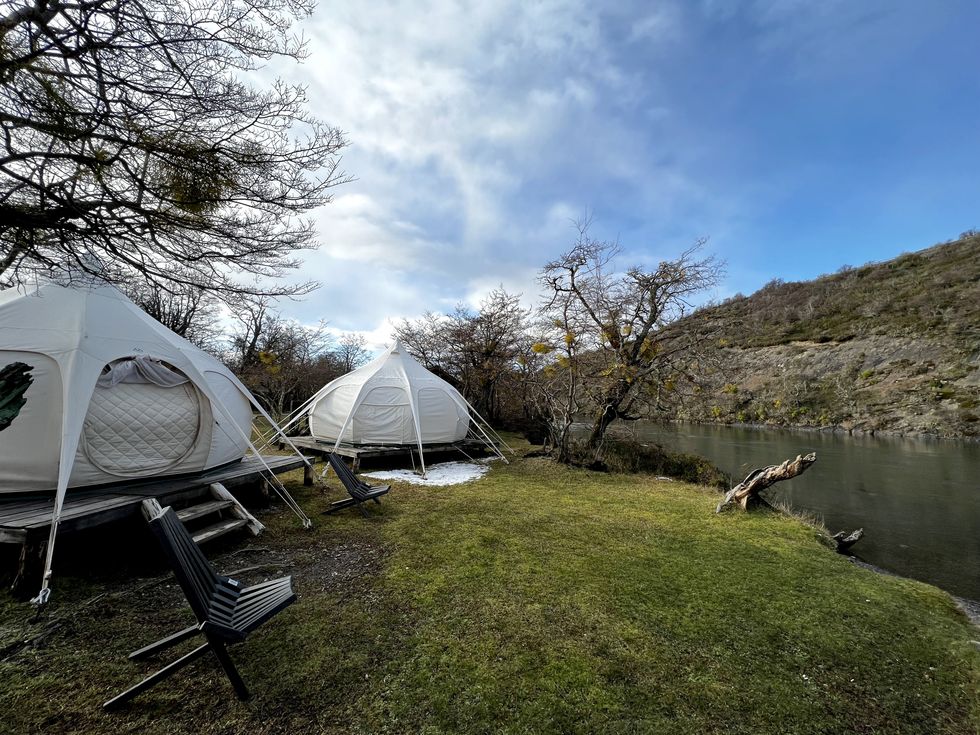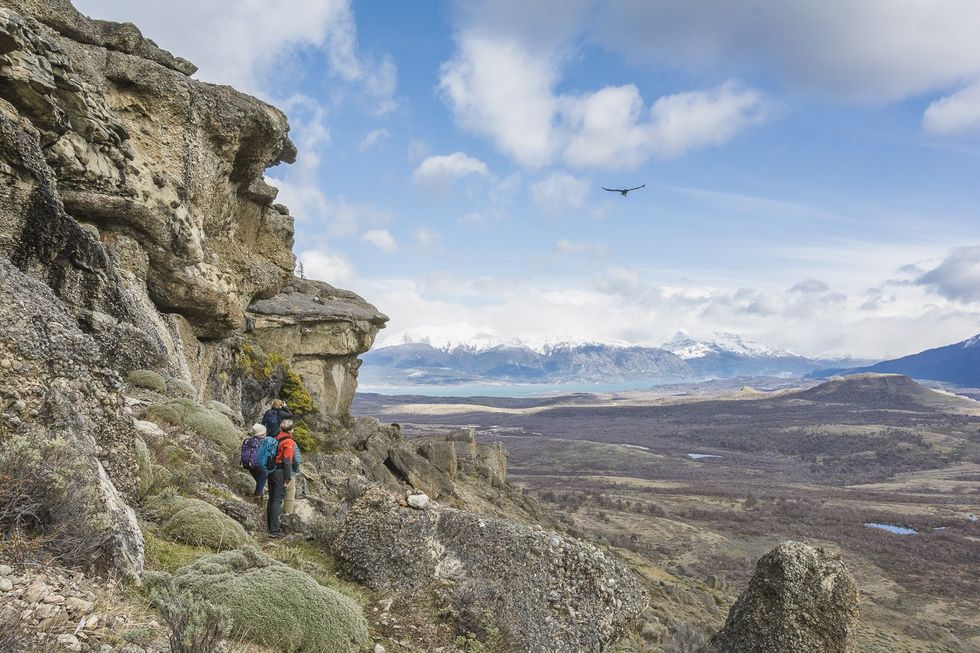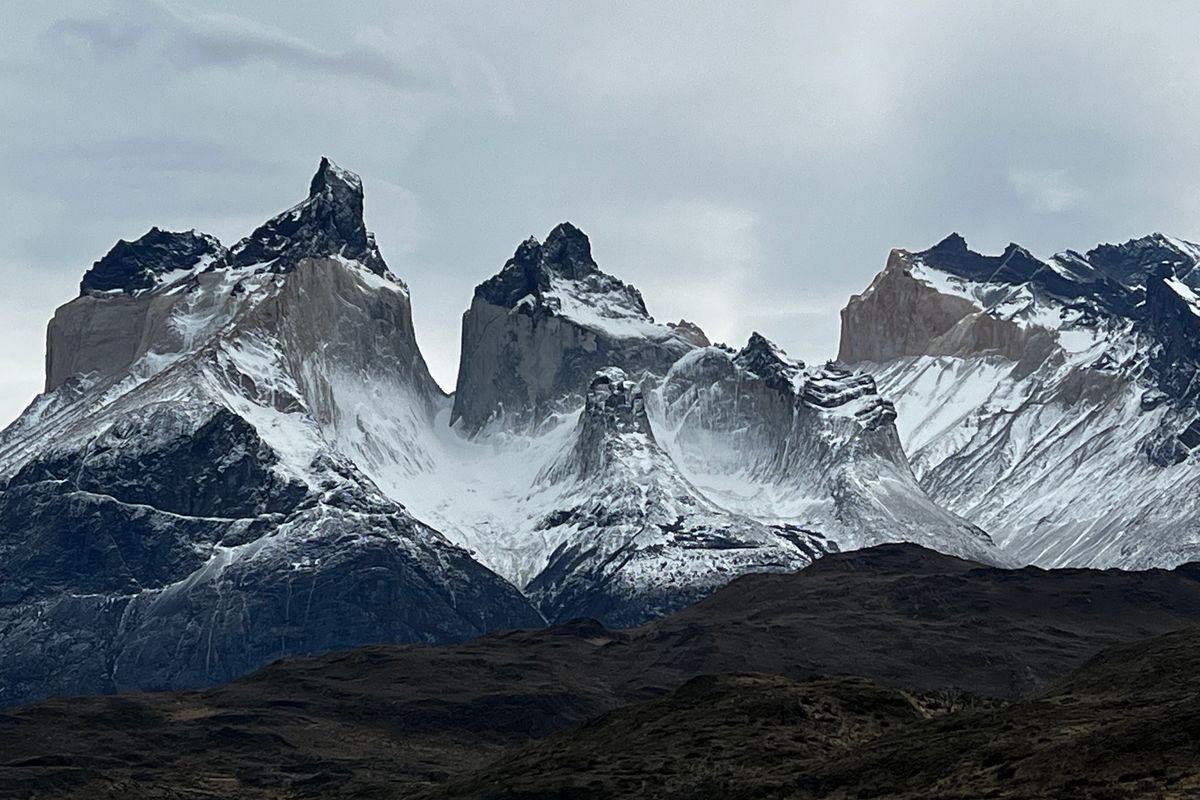From our riverside campsite in Patagonia, I peered at the grand Paine Massif, a snow-topped mountain range that looked as if powdered sugar had been dusted across it from the heavens.
The jagged peaks were both rugged and majestic. Bundled in multiple layers—wool, fleece, down, windbreaker—the bitter wind stung my cheeks as I pondered how the next days would unfold. I was gearing up to trek across pampas and up mountains in the challenging but inspiring terrain of Chile’s Torres del Paine National Park.

Our trusty Chile Nativo guides, Tim and Mayi, knew the terrain well and would set the pace for our daily outings and educate us about flora, fauna, history, and Chilean culture along the way. They would make sure we had the proper attire and equipment based on each day’s itinerary and weather, and ensure we had enough food and water to keep us nourished for the physical feats.
Our home base was an eerily silent, secluded camp along the Serrano River. I’d never witnessed swift water not making a sound. We each had our own lotus tent—canvas on the outside with a quilted lining on the inside, perched on a wooden platform—and shared public restrooms with showers that were lukewarm if you were lucky. There was no electricity and no heat in the tents, just a blowup mattress, down comforter, some heated water bottles, and lots of layers to keep the literally freezing temperatures from creeping in. But the camp also featured a modern lodge where we warmed ourselves around a wood-burning stove, peered out the large windows at views of the stunning landscape, ate delish gourmet meals featuring Chilean comfort foods, met for après hike Chilean wine and pisco sours, and attended daily briefings to prepare us for each day's journey.
Known for its harsh weather, Patagonia is hard to get to and widely unexplored. Those conditions make it daunting yet alluring, provide an environment for unique and interesting wildlife, and make it that much more special for the more than 300,000 tourists a year who come in search of untouched beauty at Torres del Paine National Park. The Chilean National Forest Service expects the number of visitors to the park to increase by more than 10% each year. Luckily, organizations such as Sustainable Travel International are heading up efforts to address the long-term health of the park and its surrounding community to combat the increase in tourism.

You don’t have to climb a peak or camp in the snow to “do” Patagonia. A day-long stroll along a river or through a burnt forest will expose you to a variety of colorful birds with melodic songs, massive condors soaring right over your head, various species of lichen and moss in 50 shades of green, adorable off-white and camel-colored guanacos grazing in the pampas, and bright blue icebergs slowly melting into the deep blue lake. It is a wonderland not to be missed.
My trip was more intense. Our daily activities consisted of hiking approximately six to seven hours a day with mileage ranging from two to 14 miles and elevation gains from 500 to 2,000 feet. We took it slow, stopped for brown bag lunches, and made sure we were present in the moment rather than worrying about getting to the end.
There are many pluses to hiking in Torres del Paine. First, it's at sea level which, being from coastal California, I was grateful for. It was a welcome relief to not have to worry about trying to catch my breath. Second, you can drink the water straight from the source. Many of the rivers and streams are fresh glacier water and do not contain the harmful bacteria that will make you sick. Lastly, I did not come across anything that was deadly—no bears, deadly spiders, snakes—and the pumas could care less about humans since they are not threatened by us.
The two most traveled (and very challenging) trekking circuits, the W and the O, take multiple days to finish. For day hikers, one of the most popular routes is to the base of the iconic Towers, three enormous granite spires on the Base Torres Trail. It is a long, arduous hike that is posted all over social media as “the” thing to do in the park. Our group had planned on tackling it but the trail got washed out by a rainstorm. Disappointed, we opted for an area of the park less traveled, one that could only be accessed with a guide. Tim led us to the top of Mirador Ferrier, a strenuous two mile hike straight up the mountain.
For the trek to the peak, we waded through ankle-deep mud, hiked up a path that had basically turned into a waterfall, crossed an area of snow that was knee deep if you weren’t careful where you walked, and heaved ourselves up steep manmade wooden plank steps. We arrived at a lookout that gave us a bird's eye view of several lakes and the impressive Paine Grande mountain. It was glorious and well earned. We all high-fived at the top and took a group photo of our accomplishment. At that moment, I don’t think any of us regretted not doing the Towers trek. We learned that going off the beaten path can be just as good—often better—than visiting the sites that everyone else visits.

"Can you hear it?" Tim said to the group while he stood still, his eyes scanning the Patagonia pampas that stretched out before us as far as we could see. We all paused to listen for a sound we'd never heard before. "You'll know it when you hear it," he said. "It's a high-pitched call that the guanacos make to warn each other that a puma is nearby."
"Can you demonstrate it for us?" someone joked, hoping to cajole Tim into making a mockery of himself.
Tim shook his head. "Nice try," he said. We all laughed.
We hiked in silence along a dirt path that traversed through the grasslands near Laguna Amarga hoping to spot the elusive creatures that call this area home. Tim worked with Jorge, a skilled puma tracker (a leonero), to find where the pumas might be lurking. With an exceptionally high density of the big cats in Torres del Paine (an estimated 100), it is the most sought-after destination on Earth for watching and photographing their grace.
The landscape was breathtaking—tall yellow grass danced in the wind, pristine lakes were a dark turquoise blue, snow-covered mountain peaks touched the clouds. I watched in wonder as five different pumas stalked their prey, wandered the pampas, napped in the tall grass, and even snuggled with their cubs. It's something I will never forget.
Patagonia's rugged terrain, unpredictable weather, and intimidating wildlife can be about pushing yourself, about balancing risk versus reward, about finding out what you’re truly capable of and how much you can endure. But the true essence of Patagonia is not what you accomplish and the photos that you take but how it makes you feel. You take home the memories of the people you met that become lifelong friends, a sense of wonder and awe, and a willingness to forgo the paths most trekked, wherever you travel.





















